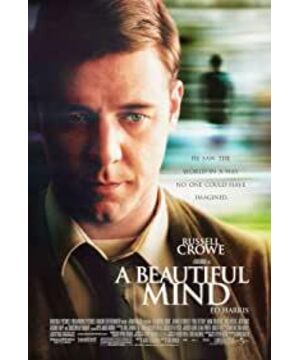"Beautiful Mind" is a very human drama about a real genius. The handsome and very weird Nash made amazing mathematical discoveries in his early years and began to enjoy an international reputation. However, Nash's outstanding intuition was plagued by delusional schizophrenia, which changed his glorious journey to the highest academic level. Faced with this challenge that once destroyed many people, Nash, with the help of his beloved wife, Alicia, fought stubbornly without fear. After decades of hard work, he finally defeated this misfortune and won the Nobel Prize in 1994. Throughout the film, several hallucinations in Nash are very representative from the perspective of psychoanalysis. One is the first fantasy character created by Nash to relieve his inner anxiety about failure-Portuguese roommate Charles. Charles and Nash's rigid personality are completely opposite. After Nash was hit, he fell into anxiety and despair, he kept encouraging Nash, admitting that he is a genius, and self-pity Nash undoubtedly needs such recognition and encouragement. Therefore, on the one hand, the appearance of hallucinations heralds the outbreak of Nash's illness, and from another perspective, it is also Nash's unconscious self-treatment. Charles is undoubtedly a manifestation of Nash's self-consciousness. Under Nash's rational control, all self-evident emotions are vented through Charles's behavior. Charles cursed when Nash was teased, Charles was unruly when Nash gave up, Charles was ecstatic outside the door when Nash passed the thesis, and so on. Two completely different individuals constituted Nash’s split personality and the origin of his schizophrenia. fierce. In the film, Nash also appeared in the illusion of Pach, an official of the Ministry of Defense, which was produced by Nash's heroic complex and represented the prototype of evil. He was brutal, rude, overbearing, and full of destructive power. It must be said that this part of Nash's conception is inseparable from the social environment at the time. The explanation of the Soviet threat theory by a professor at Princeton University, two trips to the Pentagon to decipher the Soviet code intercepted by the Ministry of National Security, the dual role of heroism and schizophrenia constructed the prototype of Pacher. For a codebreaker, it was his occupational disease to discover and solve the confusing incident. Nash broke the code but did not understand the meaning of these incoherent words. The natural curiosity in human nature prompted him to conceive a mysterious figure. , He took Nash to explore and gave Nash a magical identity and power. It can be said that the appearance of Pacher is also a manifestation of Nash's self and the prototype of Nash's heroism. As for the little girl Matthew, she can be seen as a projection of Nash's true self: lonely, helpless, pitiful, and in need of someone's caress. After removing the "genius" personality mask, Nash is essentially such an innocent and fragile older child. The higher the achievements of great people, the more lonely and helpless they will be. As a result, in the constant entanglement of these three idiosyncratic characters constructed by Nash's true self, Nash lost his self in society. The principles of reason and reality are far from the schizophrenic Nash. The spur of these three idiosyncratic characters, Nash’s almost crazy research on semiotics, and Nash’s achievement, on the one hand, is the self-achievement of these three fictional characters, but behind this self-achievement, Nash’s spirit has been deepened. Split, contradictions intensified to a climax. Once when I was watching a movie, I couldn't tell which ones were the real characters in this movie, and how to distinguish and accept what I saw. There is a saying in "The Da Vinci Code": The brain only accepts what the eyes choose. Perhaps, when Nash discovered the so-called intelligence of the Soviet Union from the so-called intelligence magazine, the piecemeal text constitutes the so-called intelligence, which can also be explained in this way. There is also a crucial character in the story. When Nash is immersed in illusions and can no longer distinguish between reality, true and false, and is firmly controlled by illusions, Nash has always had the love of his wife, Alisha. When he is confused between truth and falsehood, at least he knows that Alisha's love is real. It was this little real emotion that allowed reason to re-enter Nash's consciousness. Alyssa's love built a bridge between Nash's unconsciousness and consciousness, and finally became an opportunity for Nash's recovery. As Nash said in his acceptance speech when he won the Nobel Prize: Love is a special feeling that cannot be inferred by normal logic. Movies always drive mental illness into the corner. Show it as weird, touching, cute, funny, capricious, miserable, or improper. Here it is just a disease, almost exhausting their lives, but for Nash and his wife, before he becomes one of the lucky ones, they may still be struggling from the brink of collapse. Beautiful hearts, just like Nash’s national heroism, just like Alisha’s infinite love for Nash, it is the beautiful hearts they all possess that can finally return to reality on the cliff of schizophrenia! The superego can be realized only when the id and the ego are fighting so fiercely in their lives; when the id and the ego realize the superego together, it is time to achieve lifetime achievements.
View more about
A Beautiful Mind reviews











